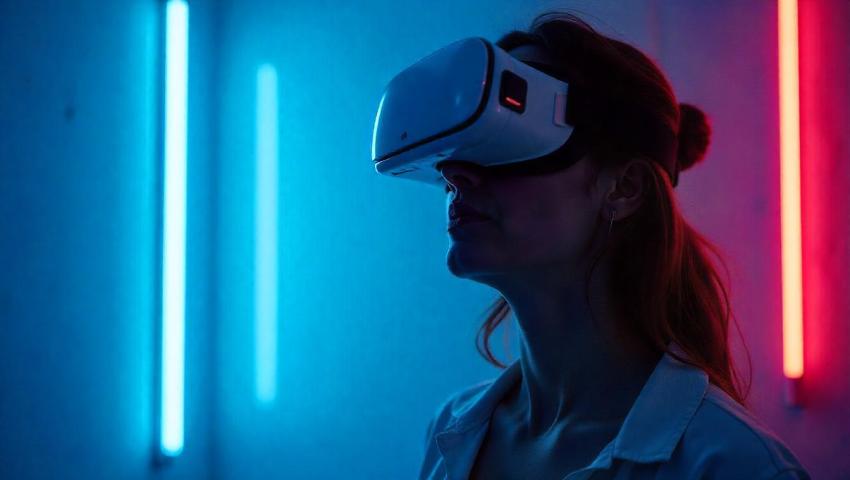
Virtual Reality Therapy: Innovative Treatment for Phobias and PTSD
Virtual Reality Therapy (VRT) is an innovative therapeutic technique that uses immersive, computer-generated environments to treat a wide range of mental health issues, including phobias and post-traumatic stress disorder (PTSD). By allowing individuals to face their fears and relive traumatic experiences in a controlled and safe setting.
Virtual Reality Therapy (VRT) represents a significant advancement in the field of mental health treatment, harnessing cutting-edge technology to offer patients an immersive, interactive therapeutic experience. VRT creates simulated environments that can replicate real-life scenarios, providing therapists with a unique tool to help clients confront and manage a variety of psychological conditions, including phobias, anxiety disorders, and post-traumatic stress disorder (PTSD). Through VRT, patients can confront fears, process traumatic memories, and practice coping strategies in a safe and controlled setting, all while under the supervision of a trained therapist.
The core of VRT lies in its ability to immerse clients in virtual environments that mimic real-world situations. This immersive experience, combined with real-time feedback from the therapist, allows individuals to gradually confront and desensitize themselves to feared stimuli or memories. VRT has been particularly effective in treating conditions such as specific phobias (e.g., fear of heights, flying, or public speaking), anxiety disorders, and trauma-related conditions like PTSD, making it a powerful addition to the therapeutic toolkit.
In this detailed exploration of Virtual Reality Therapy, we will delve into the mechanics of how it works, its applications for phobias and PTSD, the psychological mechanisms behind its effectiveness, and its future potential in mental health treatment.
The Mechanics of Virtual Reality Therapy
Virtual Reality Therapy uses computer-generated simulations to create immersive environments that can be customized to meet the specific therapeutic needs of the client. These environments are experienced through virtual reality headsets, which provide 360-degree views and realistic sounds, enabling the user to feel as though they are physically present in the simulated world. The therapist controls the scenarios within these virtual environments, allowing for gradual exposure to the client's fears or traumatic memories.
1. Components of VRT
- Virtual Reality Headset: The headset is the primary piece of equipment used in VRT. It provides the visual and auditory stimuli needed to create a fully immersive experience. Modern VR headsets are equipped with high-definition displays and surround sound, allowing users to engage with the virtual environment in a realistic and seamless way.
- Immersive Environments: The virtual environments created in VRT are highly customizable. These environments can replicate real-world situations, such as walking through a crowded space, flying on an airplane, or driving a car. They can also be used to recreate specific traumatic events for those undergoing PTSD treatment, allowing clients to relive these experiences in a safe, controlled manner.
- Haptic Feedback: Some advanced VRT systems also include haptic feedback devices, which provide physical sensations in response to certain stimuli within the virtual environment. For example, a haptic device might simulate the feeling of turbulence in a virtual airplane, allowing the client to experience and manage their fear of flying more effectively.
- Therapist Control and Supervision: Throughout the VRT session, the therapist remains in control of the virtual environment, adjusting the intensity and pacing of the exposure to match the client's comfort level. The therapist can also offer real-time guidance, helping the client develop coping strategies and work through their emotional responses to the simulated scenarios.
2. The Role of Exposure Therapy in VRT
VRT is grounded in the principles of exposure therapy, a well-established psychological treatment for anxiety disorders, phobias, and PTSD. Exposure therapy involves gradually and systematically exposing the individual to feared stimuli in a controlled environment. The goal is to reduce the client's fear response by allowing them to confront the stimuli without experiencing the negative consequences they anticipate.
In traditional exposure therapy, this process might involve real-world exposure to feared situations (e.g., taking an elevator to overcome a fear of heights). However, real-world exposure can be impractical, difficult to control, or too distressing for the client. VRT overcomes these limitations by providing a highly controlled and customizable environment in which clients can gradually confront their fears at their own pace.
The virtual environment allows for gradual desensitization, where clients can face increasing levels of exposure to their fears in a safe space. For example, someone with a fear of flying can begin with a simulation of sitting in an airport, then progress to boarding the plane, and eventually experience takeoff and turbulence in a virtual setting. By the time the client faces the real-world situation, they are better prepared to manage their anxiety.
Virtual Reality Therapy for Phobias
Phobias are intense, irrational fears of specific objects, situations, or activities that can significantly impact an individual's daily life. Common phobias include fear of heights (acrophobia), fear of flying (aviophobia), fear of spiders (arachnophobia), and fear of public speaking (glossophobia). Traditional treatment for phobias often involves cognitive-behavioral therapy (CBT) and exposure therapy, both of which focus on helping individuals confront and reframe their fears.
Virtual Reality Therapy offers a revolutionary approach to treating phobias by allowing individuals to face their fears in a controlled and safe environment. Through VRT, clients can experience realistic simulations of their phobia-inducing situations while working with a therapist to manage their emotional responses and develop coping strategies. The ability to control the pace and intensity of the exposure makes VRT an ideal solution for clients who may find real-world exposure too overwhelming or impractical.
1. Treating Acrophobia (Fear of Heights) with VRT
Acrophobia, or the fear of heights, is one of the most common specific phobias. Individuals with acrophobia experience intense fear and anxiety when exposed to high places, such as tall buildings, bridges, or even staircases. This fear can lead to avoidance behaviors, limiting the individual's ability to engage in everyday activities or enjoy certain experiences.
In VRT for acrophobia, clients are gradually exposed to virtual environments that simulate various heights. For example, they might begin by standing on the first floor of a building, then gradually work their way up to higher floors, eventually simulating experiences such as looking out from a rooftop or crossing a high bridge. Throughout the process, the therapist guides the client in using relaxation techniques and cognitive strategies to manage their anxiety.
Research has shown that VRT can be highly effective in reducing symptoms of acrophobia. In one study, individuals who underwent VRT for acrophobia experienced significant reductions in their fear of heights and were able to engage in real-world activities involving heights more confidently.
2. Treating Aviophobia (Fear of Flying) with VRT
Aviophobia, or the fear of flying, is another common phobia that can significantly limit an individual's ability to travel or enjoy life experiences. Traditional exposure therapy for aviophobia might involve gradual exposure to real-world flying situations, but this can be difficult and expensive to arrange.
VRT provides a practical alternative by allowing individuals to experience the various stages of flying within a virtual environment. Clients might begin by sitting in a virtual airport, then progress to boarding the plane, experiencing takeoff, and eventually facing more challenging stimuli such as turbulence. The therapist can control the level of intensity throughout the process, helping the client gradually build their tolerance to the experience.
Studies have demonstrated that VRT is an effective treatment for aviophobia, with clients reporting reduced fear of flying and increased confidence in their ability to manage their anxiety during real-world flights.
3. Treating Social Phobia (Social Anxiety Disorder) with VRT
Social phobia, or social anxiety disorder, is characterized by an intense fear of social situations and a fear of being judged or embarrassed in front of others. This fear can lead to avoidance of social interactions, making it difficult for individuals to form relationships, perform in public, or engage in everyday activities such as speaking in meetings or attending social events.
VRT can help individuals with social phobia by simulating common social situations, such as giving a presentation, attending a party, or engaging in small talk with strangers. Clients can practice their social skills in a safe, controlled environment while receiving guidance from their therapist on managing anxiety and building confidence.
By gradually increasing the complexity of the social scenarios, VRT helps individuals desensitize to their fear of social interactions, making it easier for them to engage in real-world social situations without overwhelming anxiety.
Virtual Reality Therapy for PTSD
Post-traumatic stress disorder (PTSD) is a condition that can develop after experiencing or witnessing a traumatic event, such as combat, sexual assault, natural disasters, or accidents. Individuals with PTSD often experience flashbacks, nightmares, and intrusive thoughts related to the traumatic event, as well as heightened anxiety, hypervigilance, and emotional numbing.
One of the most effective treatments for PTSD is exposure therapy, in which individuals are gradually exposed to reminders of the traumatic event in a controlled setting. However, for many individuals with PTSD, reliving the trauma through traditional exposure therapy can be overwhelming and distressing. VRT offers a more controlled and customizable approach to exposure therapy, allowing individuals to confront their trauma in a safe and supportive environment.
1. How VRT Treats PTSD
In Virtual Reality Therapy for PTSD, the therapist works with the client to create a virtual environment that simulates aspects of the traumatic event. This might involve recreating a combat scenario for a veteran with PTSD, simulating a car accident for someone who has experienced a traumatic crash, or recreating a natural disaster for a survivor of a hurricane or earthquake.
The therapist carefully controls the intensity of the exposure, ensuring that the client is not overwhelmed. The client is guided through the experience, encouraged to confront their emotions and memories in a safe, supportive environment. Over time, the client becomes desensitized to the traumatic memories, reducing the emotional intensity of the flashbacks and nightmares.
VRT for PTSD has been shown to be particularly effective for veterans who have experienced combat-related trauma. In one study, veterans who underwent VRT reported significant reductions in PTSD symptoms, including flashbacks, nightmares, and hypervigilance.
2. The Role of Gradual Exposure in VRT for PTSD
Gradual exposure is a key component of VRT for PTSD. The therapist works with the client to gradually confront the traumatic memories in small, manageable doses. For example, a veteran with combat-related PTSD might begin by experiencing less intense virtual scenarios, such as walking through a quiet village or driving a military vehicle. As the client becomes more comfortable with these scenarios, the therapist gradually increases the intensity of the exposure, eventually simulating more stressful or traumatic events.
Throughout the process, the therapist helps the client develop coping strategies, such as relaxation techniques and mindfulness practices, to manage the emotional and physical responses to the traumatic memories. The goal is to help the client process the trauma in a way that reduces its hold over their daily life.
3. VRT as Part of a Comprehensive PTSD Treatment Plan
While VRT can be a powerful tool for treating PTSD, it is often used as part of a broader treatment plan that includes cognitive-behavioral therapy (CBT), eye movement desensitization and reprocessing (EMDR), and other evidence-based therapies. The combination of these approaches allows for a more holistic and individualized treatment plan, addressing both the cognitive and emotional aspects of PTSD.
For many clients, the immersive nature of VRT provides a unique opportunity to confront their trauma in a way that feels more manageable than traditional exposure therapy. By allowing clients to control the intensity of the exposure and practice coping strategies in a virtual environment, VRT offers a safe and effective path to healing from trauma.
The Future of Virtual Reality Therapy
As technology continues to advance, the potential applications of Virtual Reality Therapy in mental health treatment are expanding. Researchers are exploring new ways to integrate VR into therapeutic settings, including the use of artificial intelligence (AI) to create more personalized and adaptive virtual environments.
One promising area of development is the use of VR in teletherapy, where clients can access virtual reality environments from their own homes and engage in therapy sessions remotely. This approach could make VRT more accessible to individuals who live in remote areas or who have difficulty attending in-person therapy sessions.
Additionally, the use of VR in group therapy settings is being explored, where multiple clients can engage in virtual environments together, providing opportunities for social connection and support.
As VRT becomes more widely available, it has the potential to revolutionize the field of mental health treatment, offering new possibilities for treating a wide range of psychological conditions.
Conclusion
Virtual Reality Therapy represents a groundbreaking advancement in the treatment of phobias, PTSD, and other mental health conditions. By immersing clients in realistic, customizable virtual environments, VRT allows individuals to confront their fears and process traumatic memories in a safe, controlled setting. The flexibility and adaptability of VRT make it a powerful tool for exposure therapy, particularly for individuals who may find real-world exposure too overwhelming or impractical.
As technology continues to evolve, the potential applications of VRT in mental health treatment will only continue to grow. From treating anxiety disorders to helping individuals recover from trauma, VRT offers a new and innovative approach to psychological healing, providing hope and relief to those who struggle with the burden of fear and trauma.



